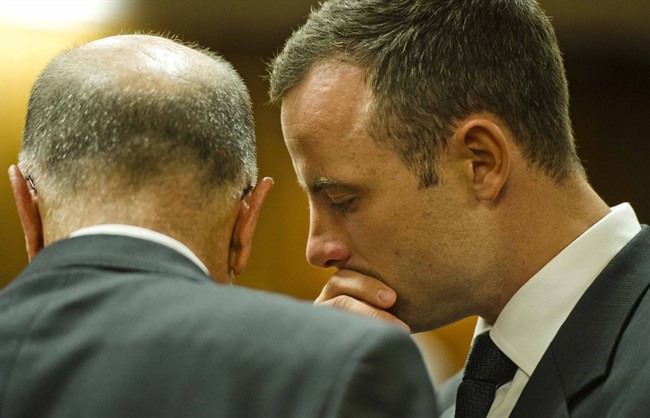PRETORIA, South Africa – During breaks in his murder trial, Oscar Pistorius sometimes confers intensely with his camp, murmuring in the ear of his chief defence lawyer. When witnesses testify, the double-amputee athlete takes notes or sits with hands clasped, occasionally covering his face, head bowed, as though troubled by the graphic accounts of how he fatally shot his girlfriend last year.

“Make way,” hefty bodyguards bark at the end of the day as they usher 27-year-old Pistorius, who is free on bail, past jostling journalists and onlookers to a vehicle with tinted windows outside the courthouse in Pretoria, South Africa’s capital.
The drama in the North Gauteng High Court captivates people around the world and especially South Africans, many of whom are getting a look at their own criminal justice system for the first time because, under a judge’s rare order, much of the trial is being televised.
READ MORE: Security guard: Oscar Pistorius told me ‘everything is fine’
At its core is the shocking tale of a woman slain in the night. The court scene has also become a stew of fallen celebrity, media circus, quirky tradition and the legal parsing of words and memories under the stern oversight of a judge who on Friday warned people in the gallery they would be “chucked out” if they misbehaved. Some discussion seems numbingly repetitive; at other times, the atmosphere is on edge, for example when a doctor testified to seeing Pistorius weeping and praying over his bloodied girlfriend, Reeva Steenkamp.
There is Pistorius’ lead lawyer, Barry Roux, in a black gown, trying to cast doubt on the testimony of prosecution witnesses in what veterans say is standard cross-examination, and what many laymen perceive as a badgering, bullying performance.
“There’s a design on your side to incriminate. And that’s unfortunate. But we’ll deal with it,” Roux said Thursday to Charl Johnson, a neighbour who said he heard a woman’s screams and then gunshots on the night that Pistorius killed Steenkamp.
Pistorius, the first amputee to run in the Olympics, has said he fired through a closed toilet door after mistaking her for an intruder in his home on Feb. 14, 2013; the prosecution alleges he intentionally killed her after an argument.
WATCH: Day 4 of Oscar Pistorius trial
Chester Missing, a puppet character that satirizes South Africa on television, tweeted: “Next Roux will be cross examining the door: Can you be sure you were closed?”
Roux swings from sarcasm to borderline hostility to a kind of patronizing courtesy with prosecution witnesses, and shows theatrical deference for the red-gowned Judge Thokozile Masipa, a former crime reporter flanked by two assistants.
“My lady, I’m in your hands,” he has said.
In a bow to tradition, the witnesses don’t directly answer Roux and chief prosecutor Gerrie Nel, instead responding “My Lady” as though they were having a conversation with the silent judge on the dais.
At one point, Nel accidentally addressed Masipa as “Madam,” drawing laughs in the austere, wood-lined room and a bashful apology from the prosecutor.
Masipa, who will deliver a verdict because there is no jury under the South African system, has warned the media not to violate a court order that limits the broadcast of witness images as well as the use of camera flashes in the courtroom. She got irritated when a reporter’s laptop made a piercing noise in court.
“Our whole justice system is on trial,” said Marius du Toit, a criminal defence attorney who is not involved in the case. He said the trial gave “ordinary folk” an insight into South African justice, arguing it sets a benchmark even if most people would be unable to afford a legal team of the calibre that is defending Pistorius.
READ MORE: Pistorius prayed next to his shot girlfriend: witness
With all the scrutiny, some were surprised at a shaky performance by a court interpreter who was translating witness Michelle Burger’s testimony in Afrikaans into English. Burger, a neighbour of Pistorius, later resorted to English after saying: “Some of the words are not what I am saying.”
The courthouse is a boxy building with an iron rail fence in front. At lunchtime, Cafe Eden on the fourth floor fills up with lawyers, journalists and sometimes members of the Pistorius family or people connected to the Steenkamp family. The two camps don’t interact.
Across the street is the colonnaded Palace of Justice, where Nelson Mandela and other anti-apartheid leaders were sentenced to life in prison in 1964. On the first day of the Pistorius trial, a small drone with cameras – presumably a media outlet’s device to get ahead of the pack – buzzed past the majestic, 19th century structure in a melding of technology and history.
At the end of the trial’s first week, a police officer explained why his unit had to be firm with people pressing for a glimpse of Pistorius.
“We must look after this guy,” the officer said. “If we leave him alone, he won’t survive.”



Comments